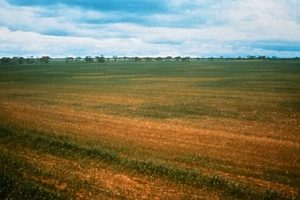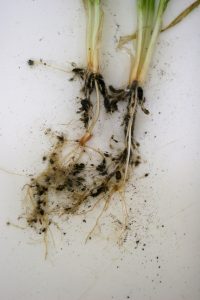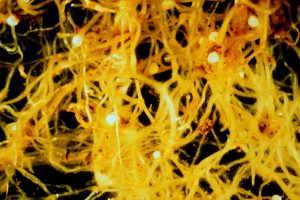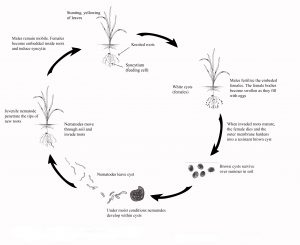Cereal cyst nematode was the most damaging soil borne disease of cereal crops in southern Australia prior to the widespread adoption of resistant cultivars during the 1990s. Losses from this disease are now rare but do still occur where nematode densities have increased when there is a high proportion of susceptible cereals sown in the rotation.
What to Look For
In-crop, CCN causes plant stunting and yellowing, which often gives the crop a ‘patchy’ appearance. Affected plant root show abnormal branching and knotting. Symptoms can be confirmed at flowering time by the presence of small white ‘cysts’ (1-2 mm in diameter) that are attached to the roots.
Disease Cycle
Cereal cyst nematode (Heterodera avenae) survives between susceptible cereal crops as eggs inside protective brown cysts that form on the roots of host plants. In the autumn, nematodes hatch from eggs in response to moisture and low temperatures (<15°C).
Nematodes hatch over a period of several weeks, with the peak hatch occurring about six weeks after the autumn break. In a further eight weeks these nematodes will form viable eggs. Therefore, to prevent CCN multiplying, it is necessary to control host plants within 10 weeks of crop germination.
Each year approximately 85 per cent of eggs hatch from cysts after the autumn break, while the remaining 15 per cent stay dormant until the following season. Therefore, it takes at least two years with break crops to control CCN. However, under very dry (drought) conditions more eggs remain dormant and an extra year of break crop is advisable.
Management
In general, CCN is well controlled and will only become a problem if grass weeds are not effectively controlled or CCN susceptible cereals are being grown. If either of these is the case paddocks should be monitored for CCN levels using a PREDICTA® B test.
Should a paddock be identified with a CCN problem then plan at least a two-year break from susceptible cereals. Extra time may be required in drought years. Timing of host removal is critical when establishing a disease break. In calculating the critical date to remove host species from break crops (i.e. grass weeds) consideration should be given to the time taken for host plants to die after herbicide application. Nematodes continue to feed until the plant is dead.
Host plants, particularly wild oats and susceptible self-sown cereals must be controlled before the nematodes have completed the development of eggs. This is approximately 10 weeks after the autumn break.
The use of resistant cereals and non-host crops, or chemical fallow in rotations as part of a two-year break, is an effective method to control CCN.
Hosts
CCN has a narrow host range that is limited to cereals and some grass weeds. Susceptible cereals and wild oats are the most important hosts. Ryegrass, brome and barley grass are poor hosts. There are lots of cereal varieties that are resistant, so it is important to consult the latest ratings to determine your risk of increasing CCN densities.
Pulses, other legumes and oilseeds are non-host crops and CCN cannot feed or reproduce on their roots and provide a good break. A chemical fallow can also provide a break if suitable in the rotation but is not necessary with many other cropping options available.








